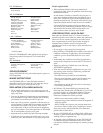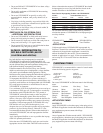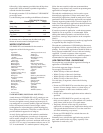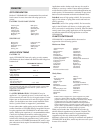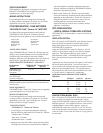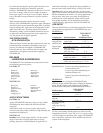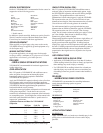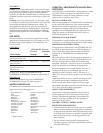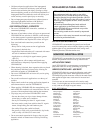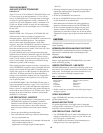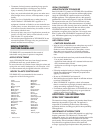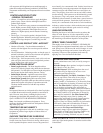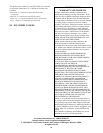
•Treatment of mixed pastures containing forage species
other than bermudagrass or bahiagrass may result in
injury or mortality to the other forage species.
• Injury may result when desirable grasses are under stress
from drought, insects, disease, cold temperature, or poor
fertility.
• Injury to or loss of desirable trees or other plants may
result if DuPont™ VELPAR® DF is applied or if
equipment is drained or flushed on or near desirable trees
or other plants, on areas where their roots may extend, or
in locations where the chemical may be washed or moved
into contact with their roots.
• Severe crop injury may occur if applications are made on
gravelly or rocky soils, thinly covered subsoils, or soils
with less than 1% organic matter.
• For broadcast pasture applications of VELPAR® DF, do not
cut treated vegetation for forage or hay nor graze domestic
animals on treated areas for 60 days.
VELPAR® DF is recommended for the control of
undesirable woody plants in pasture or rangeland.
APPLICATION TIMING
Apply VELPAR® DF from late winter through summer,
pre-budbreak until new growth hardens off.
In areas where the soil remains frozen during the winter and
spring rains are usually inadequate for soil activation, a fall
or winter treatment may be applied before the soil freezes.
WOODY PLANTS CONTROLLED
VELPAR® DF is recommended for the control or
suppression of the following species:
* Partial control.
SPRAY EQUIPMENT
AND APPLICATION TECHNIQUES
Basal (Soil)-Mix 2 2/3 pounds of VELPAR® DF with sufficient
water to make one gallon of suspension and thoroughly agitate.
Apply the VELPAR® DF suspension with an exact-delivery
handgun applicator. This equipment delivers a thin stream of
predetermined volume when triggered. Apply the VELPAR®
DF suspension at the rate of 2 to 4 ml for each inch of stem
diameter at breast height. Direct the treatment to soil within 3
inches of the root collar of woody plants to be controlled. When
treating large stems and when more than one delivery of the
VELPAR® DF suspension is needed per stem, make
applications on opposite sides of the stem. Do not apply more
than 1/3 gallon of the VELPAR® DF suspension per acre per
year. Intermittent agitation may be required to maintain the
VELPAR® DF in suspension.
USE PRECAUTIONS
- PASTURE /RANGELAND
• Injury to or loss of desirable trees or other plants may result if
VELPAR® DF is applied or if equipment is drained or
flushed on or near desirable trees or other plants, on areas
where their roots may extend, or in locations where the
chemical may be washed or moved into contact with their
roots.
• Poor weed and brush control may result from the following:
–Use on poorly drained sites
–Applications made when the soil is saturated with water and
rain is imminent within 24 hours
–Applications to soils high in organic matter (greater
than 5%)
• Following mechanical cutting or clearing, allow stumps and
injured trees sufficient time to adequately resprout before
applying VELPAR® DF.
• Do not use VELPAR® DF on frozen soils.
•Weed and brush control results depend on sufficient moisture
to activate VELPAR® DF.
• When VELPAR® DF is applied as a basal soil treatment,
there is no restriction on grazing by domestic animals nor on
cutting surrounding vegetation for forage or hay.
•For broadcast pasture applications of VELPAR® DF, do not
cut treated vegetation for forage or hay nor graze domestic
animals on treated areas for 60 days.
ADDITIONAL USE INFORMATION
SPRAY DRIFT MANAGEMENT
The interaction of many equipment- and weather-related factors
determines the potential for spray drift. The applicator is
responsible for considering all these factors when making
application decisions. Avoiding spray drift is the responsibility
of the applicator.
IMPORTANCE OF DROPLET SIZE
The most effective way to reduce drift potential is to apply large
droplets (greater than 150–200 microns). The best drift
management strategy is to apply the largest droplets that provide
sufficient coverage and control. The presence of sensitive
species nearby, the environmental conditions, and pest pressure
may affect how an applicator balances drift control and
coverage. Applying larger droplets reduces drift potential, but
Alder
American elm
Ash
Aspen
Balsam poplar
Birch
Black cherry
Blackgum
Catclaw acacia
Chinaberry*
Chinese elm
Chinese tallow
Deerbrush
Dogwood
Eastern red cedar*
Hackberry
Hawthorne
Hazel
Hickory
Huisache
Juniper
Locust
Lotebush
Manzanita
Mesquite
Mulberry
Multiflora rose
Myrtle
Oaks
Osage orange
Persimmon
Privet
Red maple
Sassafras*
Small soapweed
Snowbrush
Sourwood
Sumac
Sweet bay
Sweet gum
Whitebrush
Whitehorn
Wild plum
Willow
Yellow poplar
BRUSH CONTROL
PASTURE/RANGELAND
17



